Sunk Island Mop-up, TA21N&T(part)
8 Local Group members met at Stoney Creek on the penultimate field recording session of 2019 and for Atlas 2020. Although linear the line was broad with a range of habitats including salt marsh, flood defence bank grassland, borrow dyke and small woodland around derelict WWII buildings. In all we covered about 10 km (including the meanders) in strong wind and, for a while, driven rain. More than 100 taxa were recorded for the day. There were some additions to the hectad total, Babington’s Orache, Atriplex glabriuscula being a notable example, and there were many pre-2000 taxa put back on the map not least Melilotus altissimus. Specialist taxa included the hybrid couch Elytrigia x drucei occurring abundantly with one parent, Sea Couch E. atherica, which was confirmed later on collected material. A few plants of Rumex crispus ssp. littoreus were also noted and it was good to see Ononis spinosa in such quantity in both tetrads.
Post-script: This outing proved challenging for me and I thank those of you who hung back to ensure that I made it back perpendicularly. Medical advice will be sought on a number of issues although one is usually either dead or better before attending an appointment hereabouts!
Peter J Cook, 11 September
Heslington Tillmire
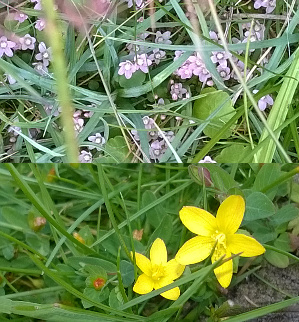 What a difference a week can make; our previous field meeting had suffered two bad-weather postponements before its cold and grey conclusion. This meeting enjoyed perfect summer weather throughout with no one daring to complain of the heat.
What a difference a week can make; our previous field meeting had suffered two bad-weather postponements before its cold and grey conclusion. This meeting enjoyed perfect summer weather throughout with no one daring to complain of the heat.
Our main recording effort was made on the northern, wetter part of the Tilmire which had only recently been vacated by its important ground-nesting birds. After a record-breaking wet June we were rather surprised by the dryness of the area, all maintaining dry feet and encountering little standing water. The highlights here were probably Marsh Cinquefoil (Comarum palustre) and Bogbean (Menyanthes trifoliata), the leaves of which were abundant in some areas, and a single patch of flowering Bog Pimpernel (Anagallis tenella – above,top). The unusual (for vc61) acidic environment also provided us with some interesting grasses - Mat-grass (Nardus stricta), Purple Moor-grass (Molinia caerulea), Heath-grass (Danthonia decumbens) and sedges - Star Sedge (Carex echinata), Flea Sedge (C. pulicaris). We also encountered interesting plants on the surrounding higher land, which included a golf course - Greater Burnet-saxifrage (Pimpinella major), Heath Groundsel (Senecio sylvaticus), Climbing Corydalis (Ceratocapnos claviculata) and Trailing St John's-wort (Hypericum humifusum – above bottom).
The drier eastern side of the Tilmire and its adjacent arable fields and ditches gave us an overall total of 190 taxa for the day.
Richard Middleton, 4 July
Driffield Millennium Green (King’s Mill Bottom) TA015576
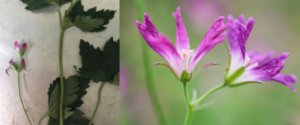 On 10 June 2019 I braved a day of drizzle to botanize the Driffield Millennium Green. We crossed
part of this 8.5 acre site last year on one of our Local Group meetings but concentrated our effort
along the tree line bordering the Keld. We missed (if they were there then) a swathe of 200+
Dactylorrhiza purpurella, 20+ D. fuchsii and 2 D. maculata - if there is any real difference between
them! Courting controversy, I note that Dactylorrhiza is now Dactylorchis and fuchsii is now a forma
of Dactylorchis maculata. One day the taxonomy will be worth committing to memory.
On 10 June 2019 I braved a day of drizzle to botanize the Driffield Millennium Green. We crossed
part of this 8.5 acre site last year on one of our Local Group meetings but concentrated our effort
along the tree line bordering the Keld. We missed (if they were there then) a swathe of 200+
Dactylorrhiza purpurella, 20+ D. fuchsii and 2 D. maculata - if there is any real difference between
them! Courting controversy, I note that Dactylorrhiza is now Dactylorchis and fuchsii is now a forma
of Dactylorchis maculata. One day the taxonomy will be worth committing to memory.
A total of 131 taxa were recorded, some of which are escapes from neighbourhood gardens. One
interesting though not particularly pretty or photogenic plant was Thurston’s Crane’s-bill, the
thurstonianum forma of the hybrid of Geranium endressii x Geranium versicolor (Geranium x
oxonianum). G. oxonianum has been recorded before in the vice county, but not this pathetic-
looking form.
Peter Cook, 11 June 2019
Paris quadrifolia re-found in a wood near Nunburnholme
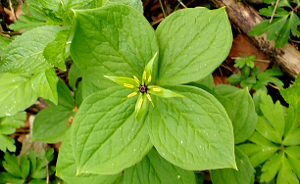 Last year, following a tip-off from Rob Jaques and with permission to visit the part of this
quiet wood not given over to pheasants, John Killingbeck and I searched and failed to find
Paris quadrifolia. However, on my next visit with Jackie Guthrie on 5 May we did manage
to locate 2 colonies of approximately 30 and 70 plants respectively along the same barely-
defined path. A grid reference was taken for each. A few days later John independently found the 2 colonies.
Last year, following a tip-off from Rob Jaques and with permission to visit the part of this
quiet wood not given over to pheasants, John Killingbeck and I searched and failed to find
Paris quadrifolia. However, on my next visit with Jackie Guthrie on 5 May we did manage
to locate 2 colonies of approximately 30 and 70 plants respectively along the same barely-
defined path. A grid reference was taken for each. A few days later John independently found the 2 colonies.
Today, on our return to monitor the plants John and I were pleased to find the original 2 colonies had increased in size to 60 and 100 plants approximately (they are close-
packed and difficult to count). Even better, in the same area we came across a further 2
colonies of 50 and 20 plants, also a tiny outpost of smaller plants not yet in flower. As the
colonies were mostly close together we took GPS readings for greater accuracy. It was good
news. Paris quadrifolia was spreading. Disquietingly, however, we also found tracks of some
sort of extreme-terrain vehicle ploughing through the narrow corridor where our plants
were located and where tree cover (Beech, Ash, Field Maple and Wych Elm) was not so
dense. It looked as if someone had been careering dow the steep slope. John thought the
Bluebells, Wild Garlic and Herb Paris would recover, unless the vandalism was repeated. A
passing visitor identified the probable culprits. At the Easter weekend she had nearly been
mown down by a group of 4-5 youths on quad bikes speeding down the path.
In view of the danger to the rare plants in the wood John and I resolved to enlist Jackie’s
help in monitoring the Paris quadrifolia and, if possible, persuading the farmer to block the
entry point with a log. We shall be keeping a close eye on the situation and monitoring plant
numbers.
Gabrielle Jarvis, 23 April 2019
 What a difference a week can make; our previous field meeting had suffered two bad-weather postponements before its cold and grey conclusion. This meeting enjoyed perfect summer weather throughout with no one daring to complain of the heat.
What a difference a week can make; our previous field meeting had suffered two bad-weather postponements before its cold and grey conclusion. This meeting enjoyed perfect summer weather throughout with no one daring to complain of the heat. On 10 June 2019 I braved a day of drizzle to botanize the Driffield Millennium Green. We crossed
part of this 8.5 acre site last year on one of our Local Group meetings but concentrated our effort
along the tree line bordering the Keld. We missed (if they were there then) a swathe of 200+
Dactylorrhiza purpurella, 20+ D. fuchsii and 2 D. maculata - if there is any real difference between
them! Courting controversy, I note that Dactylorrhiza is now Dactylorchis and fuchsii is now a forma
of Dactylorchis maculata. One day the taxonomy will be worth committing to memory.
On 10 June 2019 I braved a day of drizzle to botanize the Driffield Millennium Green. We crossed
part of this 8.5 acre site last year on one of our Local Group meetings but concentrated our effort
along the tree line bordering the Keld. We missed (if they were there then) a swathe of 200+
Dactylorrhiza purpurella, 20+ D. fuchsii and 2 D. maculata - if there is any real difference between
them! Courting controversy, I note that Dactylorrhiza is now Dactylorchis and fuchsii is now a forma
of Dactylorchis maculata. One day the taxonomy will be worth committing to memory. Last year, following a tip-off from Rob Jaques and with permission to visit the part of this
quiet wood not given over to pheasants, John Killingbeck and I searched and failed to find
Paris quadrifolia. However, on my next visit with Jackie Guthrie on 5 May we did manage
to locate 2 colonies of approximately 30 and 70 plants respectively along the same barely-
defined path. A grid reference was taken for each. A few days later John independently found the 2 colonies.
Last year, following a tip-off from Rob Jaques and with permission to visit the part of this
quiet wood not given over to pheasants, John Killingbeck and I searched and failed to find
Paris quadrifolia. However, on my next visit with Jackie Guthrie on 5 May we did manage
to locate 2 colonies of approximately 30 and 70 plants respectively along the same barely-
defined path. A grid reference was taken for each. A few days later John independently found the 2 colonies.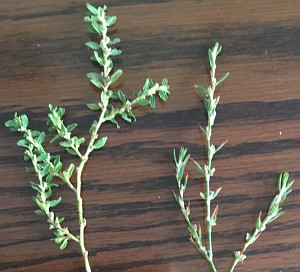 Left: P. arenastrum
Left: P. arenastrum  Searching through the plethora of magnifying lenses and loupes available on Amazon I spotted this Fancii gadget which offers LED-lit x10, x20 and x30 magnifications on a tray that slides out from a protective case. There are many similar models giving x10, x30 and x60, but I cannot see much use for x60. All models are in the price range £3.99 to £14.99 but I suspect that the cheaper ones will have poor optics. I ordered the most expensive and I am pleased with it. The x10 and x20 lenses are excellent both with and without the LED illumination. The x30 aperture is small, difficult to line up with and to focus on the object but with practice I found it good for seeing individual cell shapes in mosses and stomata. A useful feature is a 'black light' for viewing for fluorescence under UV and I am hoping this will prove useful in lichen identification. I can highly recommend this type of loupe especially for people needing to wear reading glasses and I will gladly help anyone without access to Amazon to get one, just shout.
Searching through the plethora of magnifying lenses and loupes available on Amazon I spotted this Fancii gadget which offers LED-lit x10, x20 and x30 magnifications on a tray that slides out from a protective case. There are many similar models giving x10, x30 and x60, but I cannot see much use for x60. All models are in the price range £3.99 to £14.99 but I suspect that the cheaper ones will have poor optics. I ordered the most expensive and I am pleased with it. The x10 and x20 lenses are excellent both with and without the LED illumination. The x30 aperture is small, difficult to line up with and to focus on the object but with practice I found it good for seeing individual cell shapes in mosses and stomata. A useful feature is a 'black light' for viewing for fluorescence under UV and I am hoping this will prove useful in lichen identification. I can highly recommend this type of loupe especially for people needing to wear reading glasses and I will gladly help anyone without access to Amazon to get one, just shout.
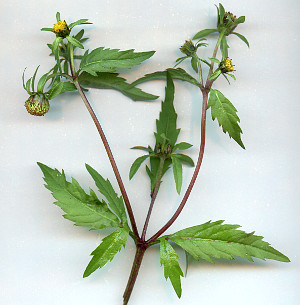 My visit to this area in June 2015 was restricted in scope to avoid bird disturbance, especially in the potentially more interesting East Cottingwith area. However, my report (News 2015) commented that 117 taxa were recorded on only a very small part of SE74B. Our Local Group meeting set out to record over a larger area in this species-rich tetrad to boost the SE74 hectad total. The area we covered was within a monad in each of the two tetrads due to restricted access, although a new pathway with boardwalk leading to two new bird hides gave us satisfactory access to parts hitherto out of bounds.
My visit to this area in June 2015 was restricted in scope to avoid bird disturbance, especially in the potentially more interesting East Cottingwith area. However, my report (News 2015) commented that 117 taxa were recorded on only a very small part of SE74B. Our Local Group meeting set out to record over a larger area in this species-rich tetrad to boost the SE74 hectad total. The area we covered was within a monad in each of the two tetrads due to restricted access, although a new pathway with boardwalk leading to two new bird hides gave us satisfactory access to parts hitherto out of bounds. 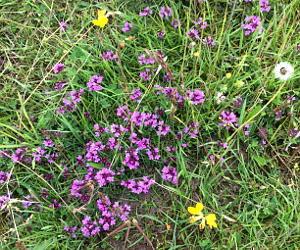 This 'roam' was part a commercial survey in a little-recorded patch of hectad SE86, the location known only to Richard. The survey site includes a deep chalk dale with very steep East- and West-facing slopes rising from 80 to 150 metres. The cattle-grazed slopes on thicker soils support colourful variants of NVC CG2 (Festuca ovina – Avenula pratensis) grassland with the typical associates Sanguisorba minor, Lotus corniculatus, Leontodon hispidus, Prunella vulgaris, Campanula rotundifolia, Galium verum, Galium album ssp. mollugo, Pilosella officinarum, Thymus praecox, Polygalla vulgaris and Helianthemum nummularium, all of them abundant and in full bloom. Small areas of eroded thinner soils have some of the best NVC CG7 (Festuca ovina - Pilosella officinarum – Thymus praecox) grassland I have ever encountered with a rich community of associates including Linum catharticum and some of the above. Anacamptis pyramidalis and Primula veris occurred locally throughout and the grasses Cynosurus cristatus, Koeleria macrantha and Briza media were frequent. A total of 127 species was recorded but the real highlight was the large area covered by these rare, species-rich grasslands. Unfortunately both Tor and thorn are poised ready to spread, especially on the wetter West-facing slopes.
This 'roam' was part a commercial survey in a little-recorded patch of hectad SE86, the location known only to Richard. The survey site includes a deep chalk dale with very steep East- and West-facing slopes rising from 80 to 150 metres. The cattle-grazed slopes on thicker soils support colourful variants of NVC CG2 (Festuca ovina – Avenula pratensis) grassland with the typical associates Sanguisorba minor, Lotus corniculatus, Leontodon hispidus, Prunella vulgaris, Campanula rotundifolia, Galium verum, Galium album ssp. mollugo, Pilosella officinarum, Thymus praecox, Polygalla vulgaris and Helianthemum nummularium, all of them abundant and in full bloom. Small areas of eroded thinner soils have some of the best NVC CG7 (Festuca ovina - Pilosella officinarum – Thymus praecox) grassland I have ever encountered with a rich community of associates including Linum catharticum and some of the above. Anacamptis pyramidalis and Primula veris occurred locally throughout and the grasses Cynosurus cristatus, Koeleria macrantha and Briza media were frequent. A total of 127 species was recorded but the real highlight was the large area covered by these rare, species-rich grasslands. Unfortunately both Tor and thorn are poised ready to spread, especially on the wetter West-facing slopes.
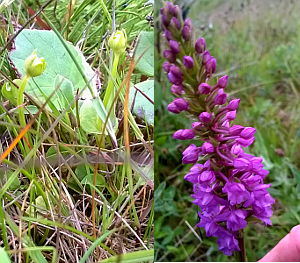 Following two postponements prompted by dire forecasts of torrential rain, this long-awaited visit finally took place. Despite the calendar, a fine drizzle and cold northerly wind provoked warm clothing (even gloves) before we could face three monads-worth of sea-cliff around Reighton Gap. But it was worth it …
Following two postponements prompted by dire forecasts of torrential rain, this long-awaited visit finally took place. Despite the calendar, a fine drizzle and cold northerly wind provoked warm clothing (even gloves) before we could face three monads-worth of sea-cliff around Reighton Gap. But it was worth it … This book by a local BSBI member, Ray Goulder, is about to be published by the
This book by a local BSBI member, Ray Goulder, is about to be published by the